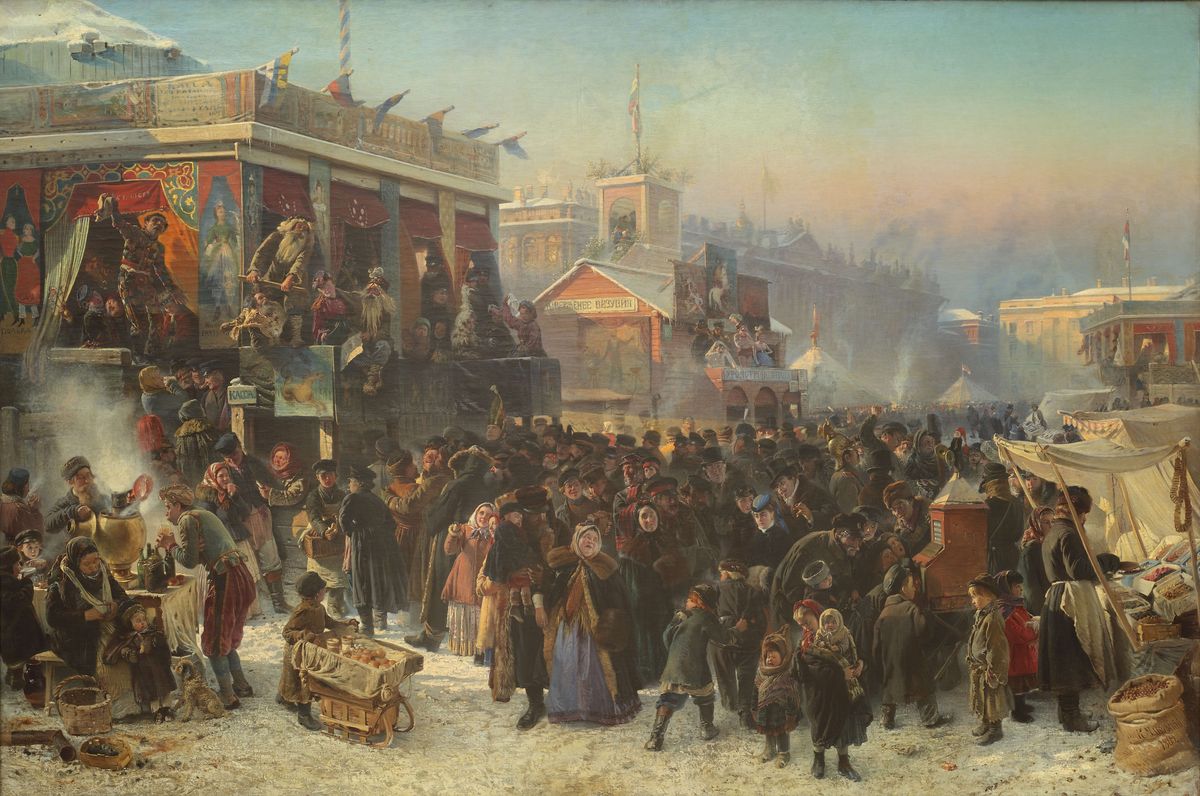


Среди жанровых работ на выставке 1869 года царила необычная по своим размерам «хоровая» картина шестидесятых годов кисти уже прославившегося К. Е. Маковского «Народное гулянье во время масленицы на Адмиралтейской площади в Петербурге», живо передающая атмосферу праздничных развлечений мастерски запечатленной многоликой толпы. Стасов так писал: «Весь Петербург гуляет и улыбается на морозе при розовых отблесках зимнего солнца. Тут и франты в pince-nez, и оборванные мальчишки; упаренные в своих салопах купчихи и балаганные актеры в плохих трико, дующие на морозе в дымящийся стакан чая; чиновники, любующиеся на паяцев, и молодцы в поддевках, ловко достающие гривну из кармана; мастеровые, толсто-хохочущее мужичье и дамочки в шикарных шляпах; солдаты и продавцы орехов и стручков»*. Картина принесла художнику звание профессора. Связь с идеями шестидесятых годов, с демократическими традициями ощущается во всех жанровых работах Маковского той эпохи. Творчество блестящего живописца – москвича по рождению, получившего первоначальное образование в Московском училище живописи и ваяния, успешно затем продолженное и завершенное в Академии художеств, стало своего рода соединительным звеном между московской и петербургской школами. Шувалова И. Н. Русское искусство 1860-х годов – вокруг Перова // Святые шестидесятые». Живопись, графика, скульптура. СПб. 2002. С. 20.
* Цит. по: Тарасов Л. М. Константин Егорович Маковский // Русское искусство. Очерки о жизни и творчестве художников. М., 1962. 1. С. 168.
Одновременно с «Тайной вечерей» из Гатчинского дворца поступили картина Г. Г. Мясоедова «Поздравление молодых в доме помещика» (1861) и одно из лучших жанровых полотен К. Е. Маковского «Народное гулянье во время масленицы на Адмиралтейской площади в Петербурге» (1869), позволяющее судить о многогранности его таланта, проявившейся уже в шестидесятые годы. Шувалова И. Н. К истории формирования коллекции шестидесятых годов в Русском музее // Святые шестидесятые». Живопись, графика, скульптура. СПб. 2002. С. 32.
Одноименный первоначальный эскиз с позднейшей подписью и датой 1870 – в ГТГ; одноименное повторение-вариант – в Одесском художественном музее.
За эту картину, экспонировавшуюся на выставке ИАХ, и картины «Наставление матери», «Беседа», «Семейная картина», «Не по силам ноша» в 1869 Маковский получил звание профессора. «Святые шестидесятые». Живопись, графика, скульптура. СПб. 2002. С. 332.
В одной из лучших картин раннего периода Маковский создал подлинную галерею колоритных типов представителей городских сословий. За это произведение художник был удостоен звания профессора АХ, где в тот период произошли коренные реформы, и бытовая живопись из гонимой превратилась в весьма поощряемую. Жанровой сцене он придал невиданный монументальный размах, представив в этом масленичном гулянье образ "всего Петербурга", как заметил В. В. Стасов, оценивший картину весьма высоко. Здесь проявился главный дар художника: талант художника-режиссера многофигурных композиций, который он совершенствовал на протяжении всей творческой деятельности. Одноименный первоначальный эскиз в ГТГ, одноименное повторение-вариант — в Одесском художественном музее.
Живописец.
Учился в Московском училище живописи и ваяния (1851-1858), в Императорской Академии художеств (1858-1863). Участник «бунта четырнадцати» (1863). Академик (с 1867), профессор (с 1869). Член Петербургской Артели художников (1863). Член-учредитель Товарищества передвижных художественных выставок (1870), Петербургского общества художников (1898). Участник выставок с 1860: в Императорской Академии художеств (1860-1873, 1881, 1890, 1892), Товариществе передвижных художественных выставок (1874, 1879-1883, 1897), Обществе русских акварелистов (1885-1891, 1901), всероссийских в Москве (1882) и Нижнем Новгороде (1896), Всемирной в Антверпене (1885) и других.

The merriest of all the traditional Russian festivals was without a doubt shrovetide. This is the Russian version of Mardi Gras, during which rites were performed to banish winter and welcome spring. The name of the holiday (Maslenitsa or Butter Week) only appeared later and springs from the lavish use of butter in the festive days, with particular respect to pancakes. The pancake was in fact the main symbol of shrovetide. Every day of Butter Week had its own special name. Monday was "meeting", Tuesday was "frolic", Wednesday was "delicacy and revelry", Thursday was "wide", Friday was "evening amusements", Saturday was "meetings of sisters-in-law" and Sunday was "forgive ness". The entire week was spent in merry and exuberant entertainment and hospitality.
The revelry reached its climax at the end of the week, reflected in the popular Russian belief that "not enjoying yourself during shrovetide brings woes and a bad end". An important feature of shrovetide in Russia was the lavish and even excessive consumption of food and drink. The basis of this gorging lay in the pagan belief that overeating would aid fertility. The theme of fertility was also reflected in the tradition of sliding down ice slopes. Play and Passion in Russian Fine Art. St-Petersburg. 1999. P. 86.
Makovsky's work is marked by a sense of celebration and colourfulness. This sense of rejoicing in life came to the fore in this early composition which was known by the shorter title Shrovetide in St Petersburg. This picture was painted when the shrovetide celebrations reached their peak in terms of scale and intensity. The painting is not only of artistic value, but also of historical and ethnographical value as a record of the fairs that existed on Admiralty Square until the early 1870s, when a fire destroyed them and they were moved elsewhere in the city. Play and Passion in Russian Fine Art. St-Petersburg. 1999. P. 90.
Painter, draughtsman, watercolourist; portraitist, genre artist, author of painting on historical themes. Studied under Mikhail Scotti, Sergei Zaryanko at the Moscow School of Painting, Sculpture and Architecture (1851–1858), under Alexei Markov at the Imperial Academy of Arts(1858–1863). Minor gold medal (1862) for Agents of the False Dmitry Kill the Son of Boris Godunov. Contributed to exhibitions (from 1860). One of “the rebellious fourteen” (1863). Academician (1867), professor (1869). Member of the St Petersburg Artel of Artists (1863). Founding member of the Society of Travelling Art Exhibitions (1870) and the St Petersburg Society of Artists (1898).



